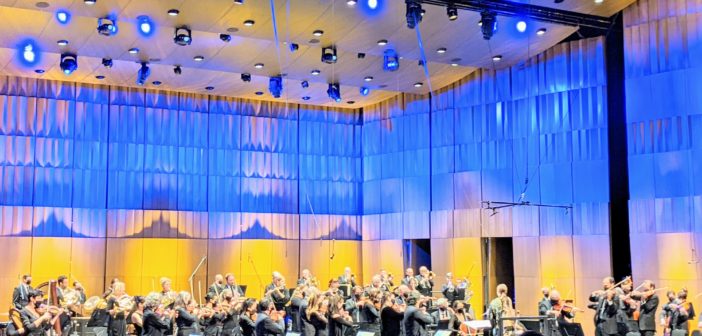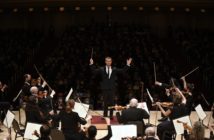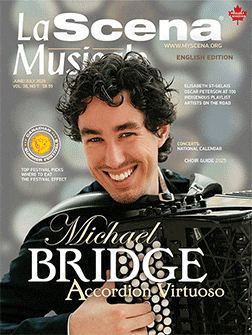If you want an example of how all art is political, you needn’t look any further than the National Arts Centre Orchestra’s Southam Hall concerts on March 9-10.
The soloist was the incandescent Venezuelan pianist Gabriela Montero, a musician who has never blanched at criticizing the greed and cruelty of the Chavez and Maduro governments. She often aims her sharpest barbs at the country’s El Sistema musical education scheme, and of her fellow musicians who promote its propaganda abroad while remaining silent on its track record of corruption and exploitation.

Joining Montero was 37-year-old Ukrainain-Finnsh conductor Dalia Stasevska. If Stasevska had not been as publicly political before Putin’s invasion of Ukraine this month, she has stepped into that role with remarkable poise and powerful eloquence.
She began the performance by reading a deeply personal, humane, lionhearted appeal on behalf of her birth country. She followed this by leading the orchestra in the solemn Ukrainian national anthem–one of the few anthems in a minor key–which the orchestra played standing, under a blue-and-yellow lighting effect. There were many Ukrainians in the audience, draped in flags, wearing their national colours, or dressed in beautiful traditional vyshyvanka (embroidered shirts), plakhta (woven skirts) and khustka (floral scarves).

After the anthem, there wasn’t a dry eye in the audience, and probably none on stage either. But Stasevska quickly mastered her emotions for the quietly churning opening measures of Wildwood, by Swedish composer Andrea Tarradi. This was the Canadian premiere of an epic work Tarradi wrote in 2016 for the Swedish Philharmonic. Tarradi is a brilliantly adept colourist and orchestrator who uses the entire depth and breadth of the orchestra to create an astonishingly diverse textural landscape. Tarradi has said she was inspired by the slow but steady growth of an oak forest, and everything here hints at primeval verticality and dense, deep-green shadows. There are keening whale sounds from double basses played on the bridge; a cataclysmic central section for strings, shimmering gongs, and to finish, an ethereal, rocking motif for glockenspiel and harp, suggesting the gentle waving and rustling of branches high overhead. The virtuosity of both writing and execution were thrilling. Wildwood would make an outstanding touring piece for NACO.

Stasevska last appeared with the orchestra in 2019. In three years, she has added mature confidence, emotional range and a sculptor’s sense of shape and space to the natural energy, intelligence and charisma she already possessed.
For Shostakovich’s Piano Concerto No.1, Montero and Staskeva were joined by NACO principal trumpet Karen Donnelly. If it wasn’t a coincidence, showcasing three women at the top of their game in this piece the day after International Women’s Day was an astute programming choice on NACO’s part.
Some ensembles and soloists have announced they will stop playing music by Russian composers, and are even boycotting Russian musicians whether they support Putin or not (on March 8, the Honens Competition announced it would be revoking invitations to Russian competitors.) However, Montero has explained on her popular Facebook page why she doesn’t agree with a blanket censure, and that she would not be swapping the Shostakovich out for a different concerto.
“Vladimir Putin continues his barbaric invasion of neighboring, sovereign Ukraine, and as self-avowedly Putin-supporting artists rightly face censure outside Russia, it is vitally important to remember that Russian culture is not on trial,” Montero posted on March 3. “The music of Shostakovich, if anything, should remind us of the heroic work of Russian artists…to oppose…the very tyranny from which the archetype of Vladimir Putin has emerged.”

Montero, Stasevska and Donnelly delivered a Shostakovich that was full of deliciously black humour and sharp, hairpin turns in mood and expression. It was a treat to hear Donnelly’s magnificent tone and shapely phrasing from the front of the stage rather than the back.
Earlier in the week, Montero had appeared with NACO soloists at the NAC Fourth Stage for some chamber music. A sophisticated, masterfully structured string quartet by Venezuelan pianist and Clara Schumann rival Theresa Carreño was followed by Poulenc’s delightful Sextet. The musicians played Dvořák’s Piano Quintet No. 2 with warm, open-hearted generosity. Principal cello Rachel Mercer’s solo in the “Dumka” Andante movement was especially moving.
Wednesday’s orchestral concert also ended with Dvořák– his Symphony No. 8. Stasevska imbued it with emotional honesty, a simple lyricism that was never cheapened by sentimentality, and, in the final movement, an exuberance that was as defiant as any act of protest. Sometimes joy–creating it, expressing it, engendering it in others–is a political act all on its own.
This concert is available as stream-on-demand for $15 until March 31 at https://nac-cna.ca/en/event/30022














